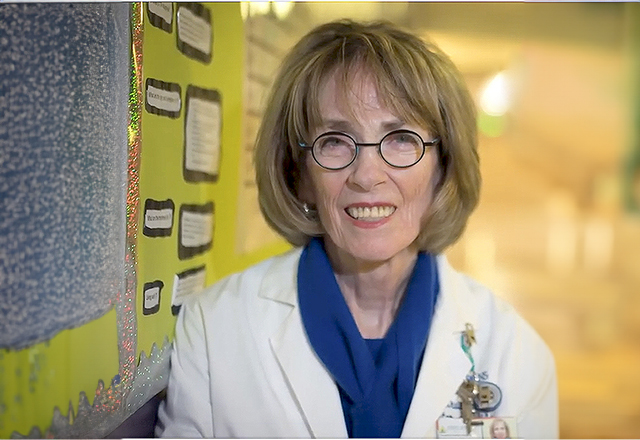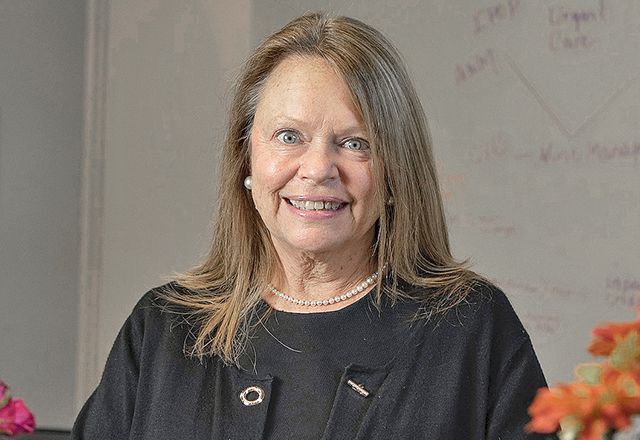A Tradition of Excellence and Innovation
50 years of cancer nursing

Magnet Recognized American Nurses Credentialing Center
Cancer Center nurses had a forward-thinking vision from the time the Center opened its doors. The treatment of patients with cancer required a level of care unique to the emerging field, in which many patients were critically ill, new drugs were being tried and bench-to-bedside research was central. Nurses helped drive improvements in patient care, sharing information about what they were seeing at the bedside. These observations inspired research that advanced patient care and improved quality of life.
Although many things have changed in cancer medicine at Johns Hopkins during the past 50 years, this high level of care and innovation has remained constant. Our nursing program has been a model for the nation, with nurses and nursing students frequently traveling to our center to observe and train with our nurses. Our nurses have played an important leadership role in setting standards of cancer care through the Oncology Nursing Society and National Comprehensive Cancer Network.
 Linda Arenth
Linda ArenthThese standards of excellence were set with the Cancer Center’s first nursing director, Linda Arenth.
From the onset, the Center’s philosophy was to provide the best bedside nursing care. Special emphasis was placed on the humanistic aspects of patient care.
Known for her forward-thinking vision, Arenth helped establish the standards for oncology nursing care that continue to guide practices today. Patients who came to the Cancer Center were each assigned a primary nurse responsible for overseeing their care. Arenth developed a unique patient acuity system, which provided a formula for determining how much nursing time patients would need based on the severity of their cancer.
 Sharon Krumm
Sharon KrummCancer Center nurses also designed the first cancer-specific chemotherapy infusion pump. Our center was the first at Johns Hopkins to recruit a psychiatric liaison nurse and nurse surgery researcher, which was virtually unheard of at the time. The inclusion of social work, counseling and other patient and family services into the treatment plan was also among the cancer care improvements forged by our nursing team.
Cancer Center nurses were key to the development of new treatments, and the drug development program helped establish the role of research nurses in the fight against cancer. Early on, nurses, including Barbara Vito Clarke and Barbara Lubeijko, became the first to manage clinical trials of new cancer drugs, recalls Ross Donehower, who helped establish the Center’s drug discovery program. To this day, when a cancer drug is given for the first time, it is nurses giving the drug and monitoring for side effects and toxicities.
 Donna Berizzi
Donna BerizziSharon Krumm, who joined the Cancer Center as nursing director in 1988, along with the assistant oncology nursing director, Connie Ziegfeld, established the Center’s internationally recognized nursing research program in 1985, one of the first in the country.
Nursing excellence was formally recognized in 2003 when the Center first earned Magnet status, a designation Kimmel nurses have continually achieved ever since.
“The level of purposeful care has never changed. It is the ongoing theme of the oncology nurse,” says Donna Berizzi, current director of oncology nursing. “The desire to innovate is always in the front of our minds. This is what is special about oncology nursing.”
 Jane Shivnan
Jane ShivnanA major advance — which remains one of the most innovative clinical endeavors in cancer medicine — was the nurse-run and developed Inpatient/Outpatient bone marrow transplant clinic (IPOP). Developed by nurse managers Jane Shivnan and Gina Szymanski, it moved one of the most intensive cancer therapies, which typically required a month or more of inpatient care, to a largely outpatient therapy. IPOP, which allows patients to recover at home or, if they live too far from Johns Hopkins, in apartment-like suites in our Hackerman-Patz Patient and Family Pavilion, improved care while lowering costs, and continues to be a national model.
The level of purposeful care has never changed. It is the ongoing theme of the oncology nurse,”
Donna Berizzi
“Such innovations can only take place when a hospital is staffed by professional and intelligent nurses,” says Krumm, who was nursing director when IPOP opened.
Cancer Center nurses are successfully treating patients in the outpatient setting whom most National Cancer Institute-designated cancer centers care for as inpatients, says Berizzi. The skill and training of Center nurses across the inpatient and outpatient spectrum of care allows nurses to be fluid and address the changing needs of patients, she says.
The shift from inpatient to outpatient care was one of the most significant advances made in cancer care, and Kimmel Cancer Center nurses helped lead this progress. Almost 80% of patients were treated as inpatients in 1977 when our Cancer Center opened, says Center Director William Nelson. Today, the majority of cancer patients are treated in outpatient clinics.
“Patients do not want to be in the hospital for a minute longer than they have to be. They want to be at home, and we want to help them be at home. We have the capacity to admit them if we need to, but we have built the infrastructure with our Viragh Outpatient Cancer Building and clinics for urgent care and ambulatory care to address every patient need. Our rooms are equipped for just about anything,” says Berizzi. “Things we never imagined before, we are imagining and following through on.”
This was never more evident than during the COVID-19 pandemic. Within days of the outbreak, Gina Szymanski, interim director of nursing and incident commander, and MiKaela Olsen, clinical nurse specialist and operations chief of the Kimmel Cancer Center’s COVID-19 Command Center, opened the Curbside Shot Clinic — a drive-up treatment delivery system — for outpatients and a special urgent care bio clinic for patients with cancer who were infected with the coronavirus.
History is important, and IPOP taught us that we can treat very sick patients as outpatients,” said Szymanski. “We don’t wing it, and we don’t place artificial limits on ourselves. What we’ve done to help our patients during COVID-19 is a continuation of what we’ve always done. We place the right patient in the right care setting with the right care provider and implement safety principles to take what we’ve traditionally done one way to meet patients where they are now.”
In a typical week, about 400 patients visit the Kimmel Cancer Center. One important service our nurses provide is guidance and education for cancer center patients and their caregivers at home, so they know when and how to take their medicines and how to recognize symptoms that require medical attention.
When they need that care, an advanced practice nurse-run urgent care clinic is available. The clinic, which opened in 2013, was developed by the nursing team and run by nurse practitioners.
“Advanced practice nurses make solid, research evidence-based decisions for care, conferring with the patient’s oncologist. These nurses are a lifeline for our patients,” says Berizzi. This is one of the biggest changes that has occurred over the history of the Cancer Center, she says. “In 1973, there weren’t many nurse practitioners. Today, advanced practice nurses are major contributors to patient care,” she says. “We have nurse-driven protocols, nurses have a seat at the table when important patient care decisions are made. We are the voice for the needs of patients and families.”
Milestones in Kimmel Cancer Center Nursing

1977 Nursing develops unique patient acuity system
1978 Nurse-run screening clinic for women at high risk for breast and ovarian cancers is started
1983 Jennifer L. Brager Memorial Award for Cancer Research is established to honor research by nurses and other nonphysicians
1984 Cancer pain team is organized
1985 The nursing research program, one of the first in the country, is started
1989 Nurses design the chemotherapy infusion pump
1992 Nursing-led research study of pain, fatigue and sleep alterations in patients with cancer is initiated
1995 IPOP center opens, moving bone marrow transplant to a largely outpatient procedure
1998 Oncology Nursing Society announces new awards given in honor of Kimmel Cancer Center nursing leaders Linda Arenth, Victoria Mock and Connie Ziegfeld
2003 Johns Hopkins nursing earns the highest credentialing honor, Magnet status
2013 Nursing-directed urgent care clinic opens
2020: Drive up shot clinic and bio-contained COVID-19 unit is established
